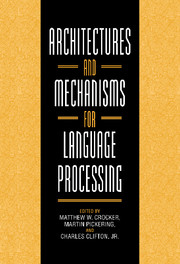Book contents
- Frontmatter
- Contents
- Contributors
- Preface
- 1 Architectures and Mechanisms in Sentence Comprehension
- Part I Frameworks
- 2 Evaluating Models of Human Sentence Processing
- 3 Specifying Architectures for Language Processing: Process, Control, and Memory in Parsing and Interpretation
- 4 Modeling Thematic and Discourse Context Effects with a Multiple Constraints Approach: Implications for the Architecture of the Language Comprehension System
- 5 Late Closure in Context: Some Consequences for Parsimony
- Part II Syntactic and Lexical Mechanisms
- Part III Syntax and Semantics
- Part IV Interpretation
- Author Index
- Subject Index
3 - Specifying Architectures for Language Processing: Process, Control, and Memory in Parsing and Interpretation
Published online by Cambridge University Press: 03 October 2009
- Frontmatter
- Contents
- Contributors
- Preface
- 1 Architectures and Mechanisms in Sentence Comprehension
- Part I Frameworks
- 2 Evaluating Models of Human Sentence Processing
- 3 Specifying Architectures for Language Processing: Process, Control, and Memory in Parsing and Interpretation
- 4 Modeling Thematic and Discourse Context Effects with a Multiple Constraints Approach: Implications for the Architecture of the Language Comprehension System
- 5 Late Closure in Context: Some Consequences for Parsimony
- Part II Syntactic and Lexical Mechanisms
- Part III Syntax and Semantics
- Part IV Interpretation
- Author Index
- Subject Index
Summary
Introduction
An important goal in psycholinguistics is uncovering the architecture of human sentence comprehension. Most of the important issues in the field of sentence processing are questions about some aspect of the underlying architecture – for example, the relation of grammar and parser (Chomsky, 1965,1980; Miller, 1962; Stabler, 1991), the modularity of syntactic processing (Ferreira & Clifton, 1986; Fodor, 1983; Forster, 1979; Frazier & Clifton, 1996; Just & Carpenter, 1992; Mitchell et al., 1992; Rayner et al., 1992), the number of interpretations pursued in parallel (Clark & Clark, 1977; Gibson, 1991; Gorrell, 1987; Kurtzman, 1985; MacKay, 1966), or the relation of linguistic processing to central cognition (Forster, 1979). The first goal of this chapter is to define precisely what it means to have a functionally complete sentence-processing architecture. The view of architecture developed here draws on general work on architecture in cognitive science (Anderson, 1983; Newell, 1973, 1980a, 1990; Newell & Simon, 1972; Pylyshyn, 1984), rather than focusing exclusively on the issue of modularity that has dominated discussions in sentence processing. This architectural analysis defines a set of functional constraints on theories, sharpens the set of questions that need to be answered, and reveals that some common theoretical approaches, including modularity, are incomplete in significant ways. The claim is that theories of human sentence processing should take the form of complete computational architectures.
- Type
- Chapter
- Information
- Architectures and Mechanisms for Language Processing , pp. 56 - 89Publisher: Cambridge University PressPrint publication year: 1999
- 5
- Cited by



